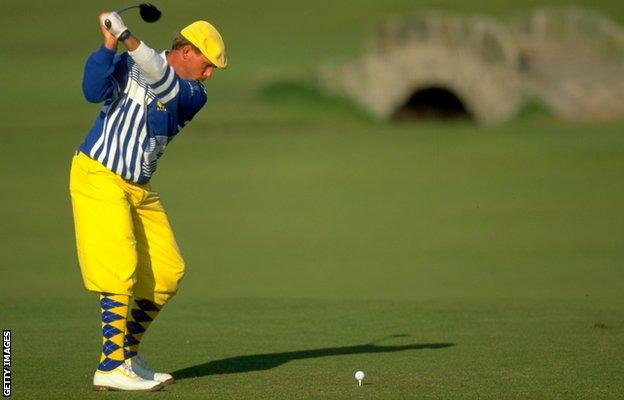A champion and a statesman - 20 years on, the tragic loss of Payne Stewart
- Published
- comments

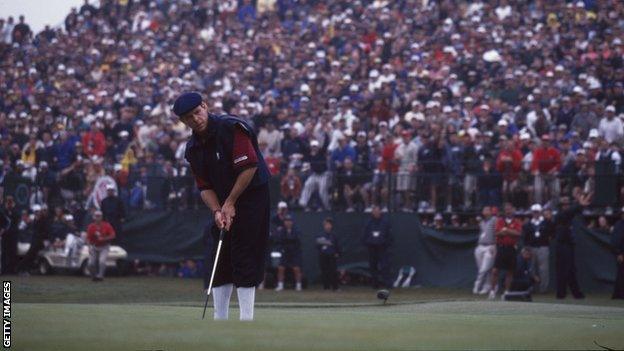
Stewart won the US Open for a second time in June 1999, four months before his death
On October 25, 1999, a private jet took off from Orlando International airport for Texas with the reigning US Open champion on board. It never reached its destination, and millions of TV viewers witnessed the tragedy of its final flight.
The aircraft plunged from the sky more than a thousand miles from where it should have landed, killing its two pilots and four passengers.
The plane hit the ground with such force it disintegrated beyond any possibility of investigative reconstruction.
The jet crashed after the cabin suffered depressurisation, starving the occupants of oxygen. Fighter jets were scrambled and tracked the flight, but were powerless to intervene.
Payne Stewart was the star of sport who perished. He was charismatic, one of the most popular players on the planet and a technicolour figure in the often monochrome world of professional golf.
He always stood out, from the moment in his brash younger days when he decided to wear jaunty plus-four trousers as his trademark playing attire. His father, a salesman, had told him it was important to be different.
Stewart had been heading to the Tour Championship, a big-money event for the 30 best golfers on the PGA Tour. Before arriving at the Houston tournament he planned to stop in Dallas to discuss a course design project.
He was accompanied by his agents Robert Fraley and Van Ardan, along with course architect Bruce Borland. Their pilots were Michael Kling and Stephanie Bellegarrigue.
"It's fascinating the number of people who know where they were and what they were doing that day," says Kevin Robins, author of the recently published book The Last Stand of Payne Stewart.
"I was a reporter in St Louis, Missouri, at the newspaper there. I remember all of us standing around a television.
"It was so stunning, it made no sense, it was discombobulating. A plane up there, so high in the air flying by itself and was it going to land in a city?
"Nobody knew. There were so many questions and no answers."

There was nothing amiss when Learjet 35 N47BA made a short hop from Sanford to Orlando's International airport before its final flight.
Once Stewart and his entourage boarded, it taxied to the runway. "Four-seven Bravo Alpha, clearance follows," radioed the ground controller. "You're cleared to the Dallas Love Field, via the JEFF Six departure, vector Cross City then as filed."
The flight took off at 09:19 local time to head north over the Florida panhandle before heading west to Dallas.
After a routine take-off, Jacksonville Air Traffic Control made contact: "November Four Seven Bravo Alpha, Jax Centre - climb and maintain flight level three-niner-zero."
This was clearance to climb to a cruising altitude of 39,000 feet. "Three-nine-zero Bravo Alpha", came confirmation from 27-year-old pilot Bellagarrigue.
These were the final words heard from the cockpit. Within two minutes controllers noticed the flight veering off course as the plane continued a northerly course.
"November Four-Seven-Bravo-Alpha contact Jax centre on one-three-five point-six five."
No response.
Soon after 10am, more than half an hour after last contact, an F16 fighter jet from Eglin Air Force base near Pensacola, Florida - piloted by Chris Hamilton - was instructed to track the LearJet.
Federal aviation authorities knew something was wrong and cleared a corridor of airspace around the plane as it ploughed northwards on autopilot.
Hamilton caught it over Memphis, Tennessee. "I got to around 50 to 100 feet from the airplane, close enough to do a good visual inspection," he said in a later interview.
There was no outward sign of damage, but there was also no indication of life on board. He radioed back: "Looks like the front cockpit is either frosted or basically condensed over. I can't see inside the cockpit."
Frozen windows indicated the pressurisation system, providing vital oxygen, had failed. All those on board must have suffered fatal hypoxia. Further F16s from the Oklahoma National Guard in Tulsa continued the pursuit.
News networks started breaking into their schedules. Word came through that a professional golfer was on board a jet flying out of control. They then identified him as Payne Stewart.
"The occupants of the plane, we are told, are non-responsive," reported CNN.
Stewart's caddie, Mike Hicks, was already scouting the course hosting the Tour Championship in Houston. He was phoned by the professional at his local club to alert him to the news.
"No, they're crazy," was all Hicks could say in response.

Professional golf tournaments usually start on a Thursday. There are four rounds of 18 holes, building to a climax when the champion is crowned on a Sunday evening.
Mondays are quiet. Golfers tend to use them to catch up with family or for corporate work.
Some head to the venue of their next event to put in extra preparation work. That week a handful of pros made a Monday visit to the Champions Golf Club in Houston.
American stars David Duval and Jim Furyk were there honing their games while officials set up the media centre and facilities. It was quiet when journalist Melanie Hauser pulled into the media parking lot.

Stewart with caddy Mike Hicks at the 1998 US Open, where Stewart almost won
But she was already aware there was something wrong. It was confirmed by the stunned silence among the early arrivals in the press tent.
"I just said 'oh my gosh, it can't be Payne!'" the veteran reporter recalls.
Hauser had known Stewart for 22 years from his college days at Southern Methodist University in Texas. "I watched him grow into an incredible man," she says.
Now she was frantically trying to prove the reports wrong; that it was not the reigning US Open champion on that stricken flight.
"We were calling his cell phone. We all got the same recorded message. Something like: 'This is Payne's cell phone, he's not with me at the moment - leave a message…'
"Someone walked past and said: 'It's definitely Payne'. I just remember putting my head on Duval's shoulder, and some tears. Then you realise, 'oh my gosh, I'm going to have to report this'."
Stewart's jet travelled over Florida, Mississippi, Tennessee, Missouri - the state of his birth - and Iowa. Now it was 48,900 feet over South Dakota with its engines having devoured 5,300 pounds of aviation fuel.
Soon after noon local time, above the small town of Mina, the LearJet began its fall. "Minneapolis, the target is descending", radioed one of the tracking F16 pilots.
"What's he doing?"
"He's doing multiple aileron rolls [a full 360° revolution]. Looks like he's out of control."
There was no fire because there was no fuel left to burn. Three hours and 54 minutes after take-off, the plane made its vertical plummet to the ground at close to the speed of sound.
It left a crater 42 feet long, 21 feet wide and eight feet deep. The 23-year-old aircraft was smashed to pieces.
Back in Houston, the Champions club was invaded by reporters never usually seen at golf events.
"People that you didn't know were hopping out of trucks and saying 'can I talk to you?'" Hauser recalls.
Like many, she struggles to believe two decades have passed since that tragic day.
"As we're talking right now, I'm visualising those guys sitting there and just falling asleep in the plane."

Stewart's distinctive attire made him a popular figure with fans, as here at the 1990 Masters at Augusta National

For all its intense competition, the rivalries it creates and the millions of dollars at stake, professional golf is a tight community. Players share the tribulations of an often maddening game.
Their wives and children co-exist in a weirdly transient and lucratively privileged collective lifestyle. Jumping on and off aircraft is as routine as driving to a supermarket for the rest of us. So the loss of one of their own hits hard.
Had any other member of the PGA Tour perished in such circumstances, they would have been mourned as if a family member had gone.
But this tragedy felt even more profound and touched a wider constituency because Stewart was so different. By the time he died at the age of 42 he was at the summit of his sport.
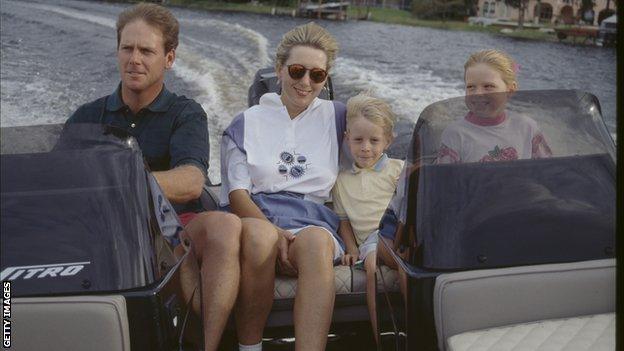
Stewart pictured with his wife and two children in 1993
He was the guy who wore the funny 'pants', he had a ready smile and a beautiful family. He had matured from being an outspoken and gauche jerk into arguably golf's most charismatic ambassador.
"So many people who loved golf in the 1990s saw Payne Stewart as their favourite player," says Robbins.
"He was Hollywood movie star good looking, he had this wonderful family, he had success - and people wanted that. In golf we lost an artist, a shot maker. He was a craftsman on the golf course."
Few would have envisaged such warm tributes when Stewart began his career as a flash, brash kid out of Springfield, Missouri.
Golf's traditions demand politeness, grace and charm from its players. "Payne Stewart really didn't reflect any of those," Robbins says. "He was loud, he was bombastic, impetuous."
When Stewart won the first of his three majors at the 1989 PGA Championship at Kemper Lakes in Illinois it was not widely applauded. A classless celebration of the capitulation of his closest rival Mike Reid was captured on TV.
Two years later he won his first US Open at Hazeltine, Minnesota, and seemed destined to dominate pro golf throughout the 1990s. But form is fickle, and when he took big money to play a different brand of clubs, the magic deserted his game.
Robbins contends this difficult playing period reformed Stewart's character. "That, I think, has an effect on a man's ego, his humility and sense of self as an athlete."
In 1998, Stewart nearly won the US Open at Olympic Club near San Francisco. He was a surprise contender but unlucky to lose. He dealt with the disappointment in a classy, generous manner as another American, Lee Janzen, triumphed.
"He had a peacefulness that he started playing with," Janzen told ESPN. "And I guess an uptightness, that sometimes came across as arrogance, went away."
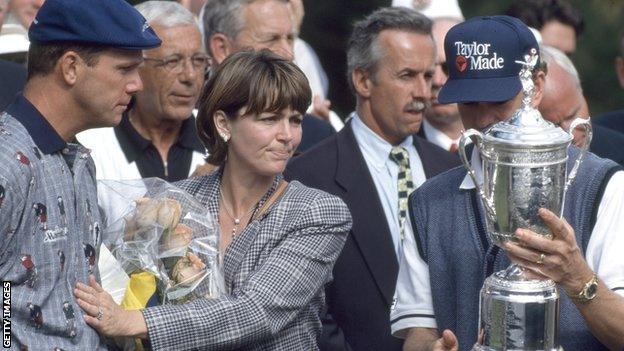
Stewart was runner-up at the US Open of 1998, won by Lee Janzen (right, with the trophy)
A year later, four months before his death, came the biggest moment of Stewart's career. He rolled in a 15-foot winning putt to deny a young Phil Mickelson and win a second US Open.
He punched the air forwards with his right fist as his right leg simultaneously kicked back. This iconic motion is captured in a statue that now stands at Pinehurst, the famed North Carolina resort where he clinched that win.
"The way he took defeat in 1998 helped him win it the next year," says Ryder Cup player and captain Colin Montgomerie. "That's why the celebration was so intense when he did win it."
The triumph meant Stewart would play for his country once again in golf's greatest event, the biennial showdown between the US and Europe for the Ryder Cup.
"The first thing he said when he came off was 'I'm in the Ryder Cup team'," recalls Montgomerie, who played against him in that 1999 match at Brookline Country Club in Boston.
"I thought 'bloody hell, that's what that means to him'."
Four months later Stewart cemented his status as a sporting statesman at that Ryder Cup. America won after an extraordinary comeback but the contest was marred by ugly scenes on the course.
Stewart's Sunday singles match with Montgomerie was at the heart of the trouble as partisan crowds yelled abuse, with the burly and temperamental Scot a primary target.
"He was very good with me," Montgomerie says. "The singles in the Ryder Cup is a big deal. I was in big trouble and he went into the crowd to have these guys ejected.
"There was a huge incident on the par-five ninth. We had to get some guy ejected in front of my father. All the carry on, it was unreal.
"And yet, he put that ahead of his own patriotism for his team. They were having their own problems to try and get to 14-and-a-half points having started 10-6 down."
By the time their game reached the 18th green, the United States had completed a remarkable victory.
Stewart could still force a tie in his personal battle with a still-determined Montgomerie, in what was the only match left on the course.
"He was on the final green in three and I was on in two," recalls Montgomerie. "He said 'look Monty, I've had enough now, pick it up' and he gave me that hole.
"I know it's easy to speak good of people who have passed but he was a decent bloke and that's all I can say about him. He was a good guy."
Had he survived, Stewart would be playing alongside Montgomerie on the Champions Tour for over-50s. As it was, that singles match at Brookline was their last encounter.
"You play him in that and a month later… Christ, he's not with us."

America's victory meant the world to Stewart. After a six-year Ryder Cup absence he had returned to the elevated stage a more rounded, mature individual playing the golf of his life.
"The last time I saw him I was up at the team room at Brookline. I looked over and he just kind of winked at me and gave me a thumbs up and threw his head back," Hauser says.
"That was Payne. You had the cockiness but you also had the 'we did it, well done'. That's what he'd grown into."
Stewart was destined to be an enduring figure in the game; a future Ryder Cup captain and ambassador for his sport.
"He was much closer to knowing who he was," observes Robbins. "Of being comfortable with his place in history and more importantly being comfortable with the man he had become."
But then he boarded that Learjet 35 for that fateful flight.
Why did it go so tragically wrong?
No definitive cause was found for the depressurisation that robbed the pilots of their cognitive skills.
Six years after it happened, a jury in Orlando found Learjet not liable for the deaths of Stewart and his agents Fraley and Ardan when a $200m lawsuit failed.
In the intervening period, a one-acre memorial was fenced off at the remote crash site in South Dakota. A rock retrieved from the resulting crater sits inscribed with the names of the victims and a psalm from the bible.
Before the tournament Stewart was supposed to be playing in that week, his fellow player Tom Lehman - with whom Stewart shared a strong Christian faith - led a service on the first tee at the Champions Club.
"He was a very emotional guy," Lehman told those who had gathered. "He loved to laugh and was not ashamed to cry.
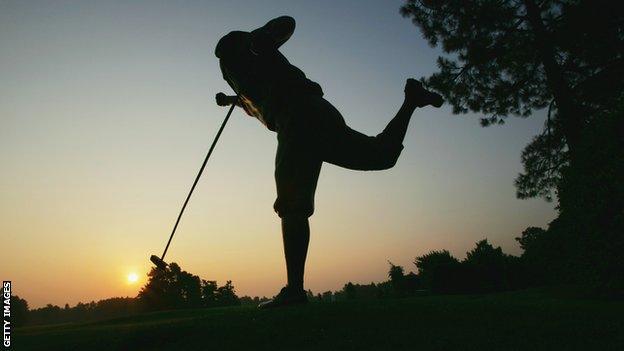
Sunrise on Stewart's statue behind the 18th green on Pinehurst's No.2 course - where he won the 1999 US Open
"I'm not ashamed of my tears this morning and neither should you be."
Later that week the remaining 29 competitors interrupted the competition to fly to Orlando for Stewart's formal memorial on the Friday. With a rejigged schedule, the tournament finished on the Sunday evening.
For the final round most players wore Stewart's trademark plus-fours in tribute. The game's new superstar Tiger Woods won the title.
At the following year's US Open at Pebble Beach in California - the first to be played without a defending champion owing to death - 21 of the world's leading golfers struck balls into the Pacific Ocean in a synchronised salute to their fallen colleague.
"That was incredible," Montgomerie says. "I thought 'what are we doing here?' We've lost a US Open champion, he's not here to defend.
"That proves what a big deal it was and especially the way he died. A freak accident. He got on a private plane - you don't even think about it."
Montgomerie contends that pro golf these days could have done with Stewart's charismatic presence. "The college kids coming out now are a bit samey, aren't they?
"They're all built of a certain mould and he wasn't. He was a character who is terribly missed."
